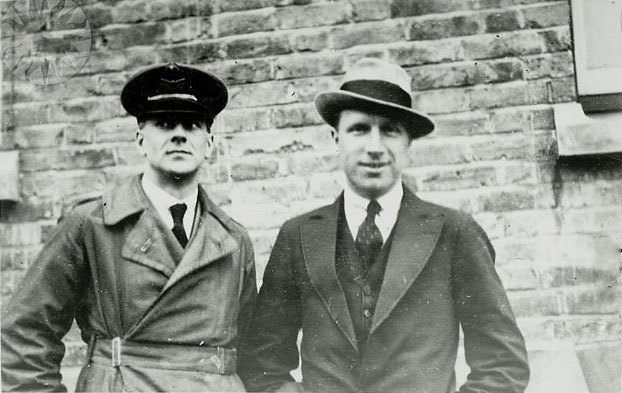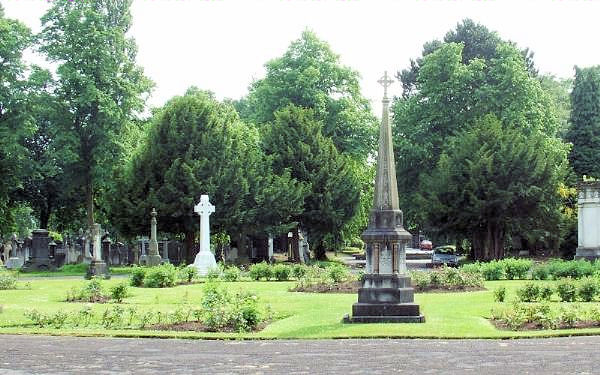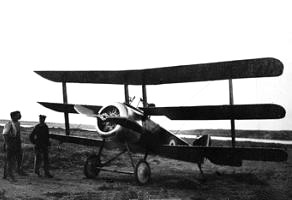|
John Alcock (RAF Officer)
Captain Sir John William Alcock (5 November 189218 December 1919) was a British Royal Navy and later Royal Air Force officer who, with navigator Lieutenant Arthur Whitten Brown, piloted the first non-stop transatlantic flight from St. John's, Newfoundland to Clifden, Ireland in June 1919. He died in a flying accident in France in December later that same year. Early life John Alcock was born on 5 November 1892, perhaps in the coach-house adjoining Basford House on Seymour Grove, Firswood, Manchester, England. He attended Heyhouses School in Lytham St. Annes. He first became interested in flying at the age of 17. His first job was at the Empress Motor Works in Manchester. In 1910 he became an assistant to Works Manager Charles Fletcher, an early Manchester aviator and Norman Crossland, a motor engineer and founder of Manchester Aero Club. It was during this period that Alcock met the Frenchman Maurice Ducrocq who was both a demonstration pilot and UK sales representativ ... [...More Info...] [...Related Items...] OR: [Wikipedia] [Google] [Baidu] |
Southern Cemetery, Manchester
Southern Cemetery is a large municipal cemetery in Chorlton-cum-Hardy, Manchester, England, south of the city centre. It opened in 1879 and is owned and administered by Manchester City Council. It is the largest municipal cemetery in the United Kingdom and the second largest in Europe. History Manchester Southern Cemetery was originally laid out on a plot of land, that cost Manchester Corporation £38,340 in 1872. Its cemetery buildings were designed by architect H. J. Paull and its layout attributed to the city surveyor, James Gascoigne Lynde. The cemetery was consecrated by the Bishop of Manchester, Bishop James Fraser on 26 September 1879, and formally opened on 9 October 1879 by the Mayor of Manchester, Charles Grundy. Within the cemetery mortuary chapels were erected for Anglicans, Nonconformists, and Roman Catholics, linked by an elliptical drive, and a Jewish chapel at the west corner of the site. The original cemetery is registered by English Heritage in the Registe ... [...More Info...] [...Related Items...] OR: [Wikipedia] [Google] [Baidu] |
Manchester
Manchester () is a city in Greater Manchester, England. It had a population of 552,000 in 2021. It is bordered by the Cheshire Plain to the south, the Pennines to the north and east, and the neighbouring city of City of Salford, Salford to the west. The two cities and the surrounding towns form one of the United Kingdom's most populous conurbations, the Greater Manchester Built-up Area, which has a population of 2.87 million. The history of Manchester began with the civilian settlement associated with the Roman Britain, Roman fort (''castra'') of ''Mamucium'' or ''Mancunium'', established in about AD 79 on a sandstone bluff near the confluence of the rivers River Medlock, Medlock and River Irwell, Irwell. Historic counties of England, Historically part of Lancashire, areas of Cheshire south of the River Mersey were incorporated into Manchester in the 20th century, including Wythenshawe in 1931. Throughout the Middle Ages Manchester remained a manorialism, manorial Township ( ... [...More Info...] [...Related Items...] OR: [Wikipedia] [Google] [Baidu] |
Alcock Scout
The Alcock Scout, a.k.a. A.1 and Sopwith Mouse, was a curious "one-off" experimental fighter biplane flown briefly during World War I. It was assembled by Flight Lieutenant John Alcock at Moudros, a Royal Naval Air Service base in the Aegean Sea. Alcock took the forward fuselage and lower wings of a Sopwith Triplane, the upper wings of a Sopwith Pup and the tailplane and elevators of a Sopwith Camel The Sopwith Camel is a British First World War single-seat biplane fighter aircraft that was introduced on the Western Front in 1917. It was developed by the Sopwith Aviation Company as a successor to the Sopwith Pup and became one of the be ..., and married them to a rear fuselage and vertical tail surface of original design (presumably by Alcock himself). It was powered by a 110 hp Clerget 9Z engine, and carried a .303 Vickers machine gun. Affectionally referred to as the 'Sopwith Mouse' by Alcock and his fellow designers, Alcock never flew it himself, but squadron- ... [...More Info...] [...Related Items...] OR: [Wikipedia] [Google] [Baidu] |
Lemnos
Lemnos or Limnos ( el, Λήμνος; grc, Λῆμνος) is a Greek island in the northern Aegean Sea. Administratively the island forms a separate municipality within the Lemnos regional unit, which is part of the North Aegean region. The principal town of the island and seat of the municipality is Myrina. At , it is the 8th-largest island of Greece. Geography Lemnos is mostly flat, but the west, and especially the northwest part, is rough and mountainous. The highest point is Mount Skopia at the altitude of 430 m. The chief towns are Myrina, on the western coast, and Moudros on the eastern shore of a large bay in the middle of the island. Myrina (also called Kastro, meaning "castle") possesses a good harbour. It is the seat of all trade carried on with the mainland. The hillsides afford pasture for sheep, and Lemnos has a strong husbandry tradition, being famous for its Kalathaki Limnou ( PDO), a cheese made from sheep and goat milk and melipasto cheese, and fo ... [...More Info...] [...Related Items...] OR: [Wikipedia] [Google] [Baidu] |
Moudros
Moudros ( el, Μούδρος) is a town and a former municipality on the island of Lemnos, North Aegean, Greece. Since the 2011 local government reform it is part of the municipality Lemnos, of which it is a municipal unit. It covers the entire eastern peninsula of the island, with a land area of 185.127 km², covering 38.8% of the island's territory. The municipal seat was the town of Moúdros (pop. 974). Its next largest town is Kontopoúli (623). The municipal unit's total population was 3,925 in the 2011 census. History During the Dardanelles Campaign of the First World War, the town and its harbour were used as an Allied base, commanded by Admiral Rosslyn Wemyss. The British Empire troops used the form ''Mudros''. On 30 October 1918, it was the site of the signing of the Armistice of Mudros, which saw the end of hostilities between the Ottoman Empire and the Allies. Moudros has a Commonwealth War Graves Commission (CWGC) cemetery for 148 Australian and 76 New Zealand ... [...More Info...] [...Related Items...] OR: [Wikipedia] [Google] [Baidu] |
Kent
Kent is a county in South East England and one of the home counties. It borders Greater London to the north-west, Surrey to the west and East Sussex to the south-west, and Essex to the north across the estuary of the River Thames; it faces the French department of Pas-de-Calais across the Strait of Dover. The county town is Maidstone. It is the fifth most populous county in England, the most populous non-Metropolitan county and the most populous of the home counties. Kent was one of the first British territories to be settled by Germanic tribes, most notably the Jutes, following the withdrawal of the Romans. Canterbury Cathedral in Kent, the oldest cathedral in England, has been the seat of the Archbishops of Canterbury since the conversion of England to Christianity that began in the 6th century with Saint Augustine. Rochester Cathedral in Medway is England's second-oldest cathedral. Located between London and the Strait of Dover, which separates England from mainla ... [...More Info...] [...Related Items...] OR: [Wikipedia] [Google] [Baidu] |
RAF Eastchurch
Royal Air Force Eastchurch or more simply RAF Eastchurch (formerly RNAS Eastchurch) is a former Royal Air Force station near Eastchurch village, on the Isle of Sheppey, Kent, England. The history of aviation at Eastchurch stretches back to the first decade of the 20th century when it was used as an airfield by members of the Royal Aero Club. The area saw the first flight by a British pilot in Britain. In 1910 it was operated by the Royal Navy as a training aerodrome and it was known as the Naval Flying School, Eastchurch. In the 1910s the airfield was designated Royal Naval Air Station Eastchurch. With the amalgamation of the Royal Naval Air Service and the Royal Flying Corps on 1 April 1918, the station was transferred to the newly formed Royal Air Force and was re-designated Royal Air Force Eastchurch. Early civilian aviation The members of the Aero Club of Great Britain established their first flying ground near Leysdown on the Isle of Sheppey in 1909. One of the Club's me ... [...More Info...] [...Related Items...] OR: [Wikipedia] [Google] [Baidu] |
Trafford Park Aerodrome (Manchester)
Trafford Park Aerodrome (Manchester) was the first purpose-built airfield in the Manchester area. Its large all-grass landing field was just south of the Manchester Ship Canal between Trafford Park Road, Moseley Road and Ashburton Road and occupied a large part of the former deer park of Trafford Hall. Today's Tenax Road runs north–south through the centre of the site of the old airfield, which was 0.7 miles northeast of today's Trafford Centre. Operations in 1911–1912 Manchester Aerodrome Ltd was formed in late 1910 to rent the land and prepare the surface for flying and this work was completed by summer 1911. The first known use of Trafford Park airfield was by Henry Melly on 7 July 1911 when he flew his Blériot monoplane, with A. Dukinfield-Jones as passenger, from his base at Waterloo just north of Liverpool to meet Alliott Verdon Roe for lunch at Trafford Hall. By prior arrangement, A.V. Roe had laid out white sheets on the aerodrome to indicate the location of t ... [...More Info...] [...Related Items...] OR: [Wikipedia] [Google] [Baidu] |
Farman
Farman Aviation Works (french: Avions Farman) was a French aircraft company founded and run by the brothers Richard, Henri, and Maurice Farman. They designed and constructed aircraft and engines from 1908 until 1936; during the French nationalization and rationalization of its aeronautical industry, Farman's assets were assigned to the ''Société Nationale de Constructions Aéronautiques du Centre'' (SNCAC). In 1941 the Farman brothers reestablished the firm as the "''Société Anonyme des Usines Farman''" (SAUF), but only three years later it was absorbed by Sud-Ouest. Maurice's son, Marcel Farman, reestablished the SAUF in 1952, but his effort proved unsuccessful and the firm was dissolved in 1956. The Farman brothers designed and built more than 200 types of aircraft between 1908 and 1941. They also built cars until 1931 and boats until 1930. Background In 1907, Henri Farman bought his first aircraft from Gabriel Voisin and soon began to improve the design of the a ... [...More Info...] [...Related Items...] OR: [Wikipedia] [Google] [Baidu] |
Sunbeam Motor Car Company
Sunbeam Motor Car Company Limited was a British automobile manufacturer with its works at Moorfields in Blakenhall, a suburb of Wolverhampton in Staffordshire, now West Midlands. Its Sunbeam name had been registered by John Marston in 1888 for his bicycle manufacturing business. Sunbeam motor car manufacture began in 1901. The motor business was sold to a newly incorporated Sunbeam Motor Car Company Limited in 1905 to separate it from Marston's pedal bicycle business; Sunbeam motorcycles were not made until 1912. In-house designer Louis Coatalen had an enthusiasm for motor racing accumulated expertise with engines. Sunbeam manufactured their own aero engines during the First World War and 647 aircraft to the designs of other manufacturers. Engines drew Sunbeam into Grand Prix racing and participation in the achievement of world land speed records. In spite of its well-regarded cars and aero engines, by 1934 a long period of particularly slow sales had brought continuin ... [...More Info...] [...Related Items...] OR: [Wikipedia] [Google] [Baidu] |
Brooklands
Brooklands was a Auto racing, motor racing circuit and aerodrome built near Weybridge in Surrey, England, United Kingdom. It opened in 1907 and was the world's first purpose-built 'banked' motor racing circuit as well as one of Britain's first airfields, which also became Britain's largest aircraft manufacturing centre by 1918, producing military aircraft such as the Vickers Wellington, Wellington and civil airliners like the Vickers Viscount, Viscount and Vickers VC10, VC-10. The circuit hosted its last race in August 1939 and today part of it forms the Brooklands Museum, a major aviation and motoring museum, as well as a venue for vintage car, motorcycle and other transport-related events. History Brooklands motor circuit The Brooklands motor circuit was the brainchild of Hugh F. Locke King, Hugh Fortescue Locke-King, and was the first purpose-built banked motor race circuit in the world. Following the Motor Car Act 1903, Britain was subject to a blanket speed limit on ... [...More Info...] [...Related Items...] OR: [Wikipedia] [Google] [Baidu] |






